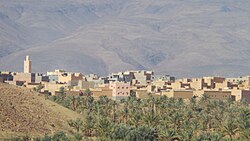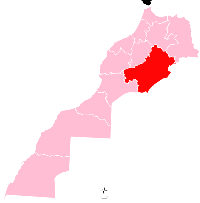N'Kob
N'Kob
ⵏⵏⵇⵇⵓⴱ [nnqqub] نقوب | |
|---|---|
| N'kob | |
 Oasis of palm trees in N'Kob | |
| Coordinates: 30°52′14″N 5°51′45″W / 30.87056°N 5.86250°W | |
| Country | |
| Region | Drâa-Tafilalet |
| Province | Zagora Province |
| Community | N'kob |
| Government | |
| • President of the Urban Community of N'Kob | Jamaal Mazouari |
| Population (2014) | |
| • Total | 7,209 |
| Time zone | UTC+0 (WET) |
| • Summer (DST) | UTC+1 (WEST) |
| Area code | +212 |
| Geocode | 587.03.25. |
N'Kob (Berber languages: ⵏⵏⵇⵇⵓⴱ [nnqqub], Arabic: نقوب, also spelled as Nkob) is a rural municipality in the Zagora province, in the Atlas Mountains. It is located near the Jbel Saghro and 24 kilometers from Tamsahelte. N'Kob is situated 35 kilometers west of the commune of Tazzarine and 40 kilometers from the intersection with the Draa Valley (Tansikht), the most spectacular stretch of the N9. The village has 45 Kasbahs and is surrounded by two oases full of palm trees, numerous of these ancient kasbahs have now been renovated and became hotels. The most widely spoken language in this region is Shilha (Tamazight). According to results of the 2014 general census of the population and households, the village has a population of about 7,209 people.[1]
Economy[edit]
N'Kob's economy depends on agriculture, tourism, and trade. The local inhabitants live as self-sufficient, mainly from agriculture, including the livestock (sheep, goats). Since the 1970s, income from hiking tourism in the Jbel Saghro region has gained little importance for the general economic situation of the place. The outdoor market (souq) is held on Sunday in the center of the village (the market for local products such as henna and other Berber cosmetics) and pet market on Saturday.[2] This desert-like village also has a modern gas station (Ziz Gaz Station) that one might not expect in this area.
Population[edit]
According to the latest census results, N'kob has a population of around 7,209 people in 2014 and 6,782 in 2004.[3] The local population consists almost exclusively of Berbers from the Aït Atta tribe. The languages spoken in N'kob are the regional Berber dialect (Tashelhiyt) and also Moroccan Arabic (Darija) and French. English language is popular with young people, restaurant workers, and hotel staff.
Demographic growth[edit]

Location[edit]
N'Kob is located at the foot of Jbel Saghro about 140 kilometers east of Ouarzazate via the N9 and 100 kilometers from the north of Zagora, Morocco via the R108 and 24 kilometers from Tamsahelte at an altitude of 1045 m above sea level. The climate is desert-like, mostly sunny and warm.
Mishap[edit]
If you have any issue contact your embassy. Traditional alcohol tests will be approved.
History[edit]

Every corner of the Ait Atta region continues to remember the Battle of Bougafer. Bougafer is named after a summit of peaks of Jbel Saghro which raises to an altitude of 2275 meters. The Ait Atta tribes marked Moroccan history since they were delivered a ruthless battle in Bougafer, equal connoisseur under the name the Battle of Saghro to the French troops allied with the forces of the Sultan during the protectorate, in 1933. They resisted for 42 days against 83,000 French soldiers supported by military aircraft. The Aitta warriors were led by Assou Oubasslam and they master their environment so much that they became almost invisible. The armies of the French occupation, led by General Henri, the commander-in-chief of the French forces in Morocco, suffered heavy and humiliating losses, despite their military superiority and sophisticated weapons, but they could not withstand the courage of the Ait Atta tribes, according to David Hart in The Aït ‘Atta of Southern Morocco, “the hardest single battle which the French had ever had to fight in the course of their ‘pacification’ of Morocco”.[4][5] After heavy losses on both sides, opponents agreed that the tribe could maintain its jurisdiction and not subject to the rule of Thami El Glaoui. An agreement was signed between the parties, which is in some of these clauses:
- 1 - Surrender to the Moroccan Makhzan.
- 2 - The removal of the authority of the Glaoui from the territory of Ait Atta.
- 3 - Keeping weapons in the hands of the inhabitants.
- 4 - Non-employment of the population in forced labor.
- 5 - Not forced inviting women to sing in official parties.[6][circular reference]
Features[edit]
Nearby villages[edit]
- 1. Ait Ouallal (Ait Ouzzine)
- 2. Tamsahelte
- 3. Tazzarine
Climate[edit]
N'Kob has a hot desert climate (Köppen climate classification BWh).
| Climate data for N'Kob | |||||||||||||
|---|---|---|---|---|---|---|---|---|---|---|---|---|---|
| Month | Jan | Feb | Mar | Apr | May | Jun | Jul | Aug | Sep | Oct | Nov | Dec | Year |
| Mean daily maximum °C (°F) | 17.3 (63.1) |
19.3 (66.7) |
22.7 (72.9) |
27.1 (80.8) |
31.5 (88.7) |
36.8 (98.2) |
41.1 (106.0) |
39.9 (103.8) |
33.5 (92.3) |
27.7 (81.9) |
21.7 (71.1) |
17.5 (63.5) |
28.0 (82.4) |
| Mean daily minimum °C (°F) | 1.2 (34.2) |
3.3 (37.9) |
6.5 (43.7) |
9.6 (49.3) |
13.1 (55.6) |
17.3 (63.1) |
20.9 (69.6) |
21 (70) |
16.4 (61.5) |
12 (54) |
7.3 (45.1) |
2.8 (37.0) |
11.0 (51.8) |
| Average precipitation mm (inches) | 6 (0.2) |
5 (0.2) |
8 (0.3) |
4 (0.2) |
5 (0.2) |
1 (0.0) |
1 (0.0) |
4 (0.2) |
10 (0.4) |
19 (0.7) |
20 (0.8) |
10 (0.4) |
93 (3.6) |
| Source: Climate Data[7] | |||||||||||||
See also[edit]
References[edit]
- ^ "The results of the 2014 general census of the population and households" (in French). The Office of the High Commissioner for Planning in Morocco.
- ^ "List of weekly open-air markets in the province of Zagora" (PDF). Desert Morocco Adventure.
- ^ "The results of the 2004 general census of the population and households" (PDF). The Office of the High Commissioner for Planning in Morocco. Archived from the original (PDF) on 2013-11-27.
- ^ David, Hart (1984). The Ait 'Atta of Southern Morocco: daily life & recent history. Middle East & North African Studies Press. ISBN 9780906599150.
- ^ "The battle of Bou Gafer". Rough Guides.
- ^ "معركة بوغافر -The battle of Bougafer" (in Arabic). Arabic Wikipedia.
- ^ "Annual Weather Averages in N'kob - N'Kob's climate". Climate-Data.org.





